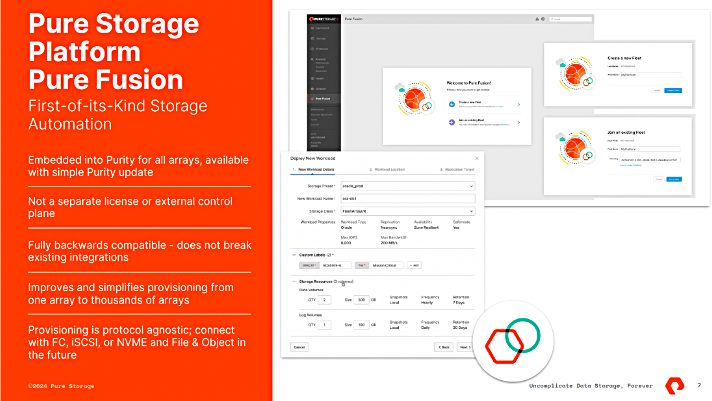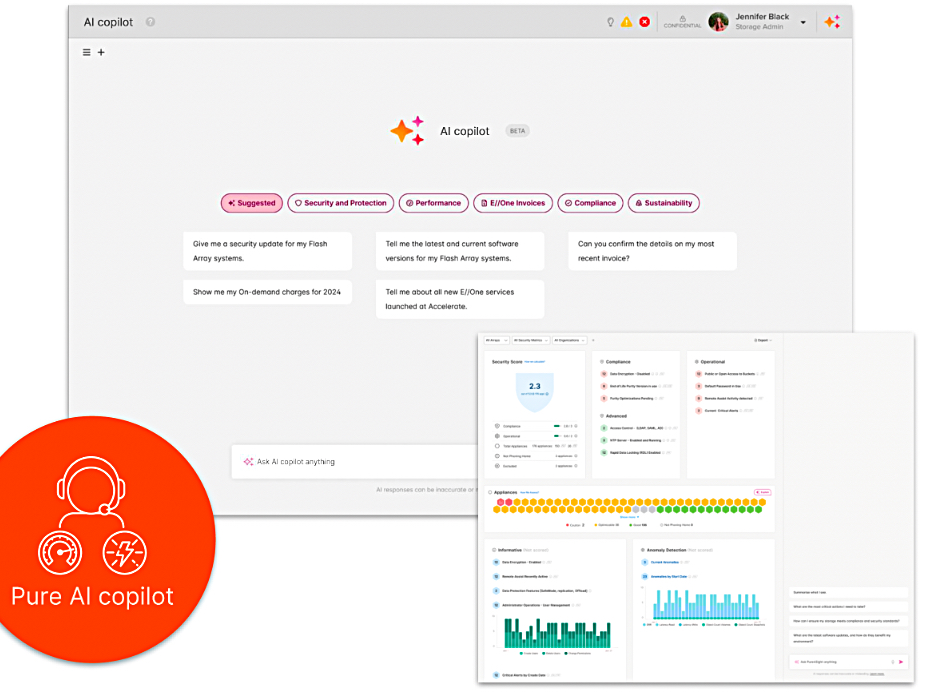Pure Storage has extended the software environment of its all-flash arrays, with fleet management and a storage Copilot, and says this has enhanced their ability to detect and recover from malicious attacks.
These additions were announced at its June 18-21 Las Vegas Pure Accelerate conference, which overlaps with HPE’s June 17-20 Discover conference in the same city. Pure made no new hardware announcements nor eye-catching deals with Nvidia, such as Nvidia AI Computing by HPE. Instead it provided solid incremental advances for its users, enhancing array fleet management and improving array SLAs and cyber resilience.
Pure chairman and CEO Charles Giancarlo said: “Pure is redefining enterprise storage with a single, unified data storage platform that can address virtually all enterprise storage needs including the most pressing challenges and opportunities IT leaders face today, like AI and cyber resilience. The Pure Storage platform delivers unparalleled consistency, resilience, and SLA-guaranteed data storage services, reducing costs and uncertainty in an increasingly complex business landscape.”
The Pure Fusion offering, which automates orchestration and workload placement, is now embedded into the Purity operating environment. It unifies arrays and optimizes storage pools on the fly across structured and unstructured data, on-premises, and in the cloud. Pure Fusion will be available across the entire Pure Storage platform to all global customers.

AI
The company is introducing a GenAI Copilot for storage, saying it “represents a radically new way to manage and protect data using natural language.” It has been trained on data from tens of thousands of Pure Storage customers, and can guide storage teams through complex performance investigation steps, management, and security issues.
Pure now provides secure application workspaces with fine-grained access controls. This combines Kubernetes container management, secure multi-tenancy, and policy governance tools to enable data integrations between enterprise mission-critical data and AI clusters. It is claimed to make storage infrastructure transparent to application owners, who gain fully automated access to AI features without sacrificing security, independence, or control.

Pure Storage already boasts Nvidia DGX BasePOD and OVX validation. It now expects to be certified storage for Nvidia’s SuperPOD by the end of the year. It claims its “industry-leading energy efficiency, consuming up to 85 percent less energy than alternative all-flash storage,” can help customers overcome data center power constraints in large AI clusters.
More Evergreen
Pure announced three Evergreen//One Storage as-a-Service (STaaS) service-level agreements (SLAs) including an AI StaaS guarantee, cyber recovery and resilience and site rebalance features, along with a new security assessment and data access anomaly detection improved by using AI.

The Evergreen//One AI Storage as-a-Service SLA guarantees storage performance for GPUs to support training, inference, and HPC workloads, and introduces the ability to purchase based on dynamic performance and throughput needs. Pure claims to deliver the required performance, thereby eliminating the need for excess planning and expenditure.
The Evergreen//One consumption-based storage array arrangement has an enhanced Cyber Recovery and Resilience SLA that includes disaster recovery. Pure will deliver a customized recovery plan, and, if a disaster occurs, ship clean service infrastructure within a defined SLA, provide onsite installation, and supply additional professional services for data transfer.
As part of this, Pure will work with customers “to build and maintain a comprehensive cybersecurity strategy.” This will include quarterly reviews to help ensure best practices, ongoing risk assessments, and operational security remediation.
Pure’s new security assessment provides visibility into fleet-level security risks, with actionable recommendations to maximize cyber resilience across a customer’s entire storage fleet. The assessment is based on aggregated intelligence across 10,000-plus Pure arrays. The assessment provides best practices to align with NIST 2.0 standards, meet regulatory compliance rules, remediate potential security anomalies, and restore operations if a security-related event occurs.
Also, the AI copilot uses this security assessment to provide CISOs with information to compare their organization’s own security posture against that of other Pure Storage customers.
The Site Rebalance SLA enables customers to adjust existing reserve commitments as storage requirements evolve. A reserve commitment is a chosen hardware configuration’s minimum storage capacity level, billed in advance at the corresponding reserve rate.
For example, if capacity needs at one site go down, a datacenter is being reduced in size or consolidated, or there is excess capacity at some site for whatever reason, the Site Rebalance SLA means customers can rebalance reserve commitments once every 12 months for each Evergreen//One subscription.
Pure already has ransomware detection based on data reduction anomalies. It has now strengthened its ability to detect unusual data access behavior, malicious access, and denial of service attacks by having multiple machine learning models running to identify anomalous behavior.
These models analyze customer environments with historical data for anomalous patterns based on heuristics of performance as well as user context on how storage is used. Pure says customers can identify a last known good snapshot copy to reduce the impact of anomalous data access by identifying recovery point targets to restore data, reducing risk and guesswork.
You can read more about how Pure says it’s tackling AI and cyber resiliency in a blog.








